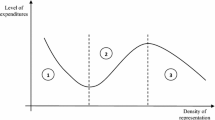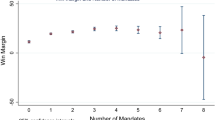Abstract
Based on the median voter model, we specify a flexible general framework of the effect of municipality size on per-capita public expenditures. Previous literature has recognized that municipality size should have a non-linear effect on the quality of public goods provision and to this end different papers have applied a range of alternative parametric specifications. Using a very large sample of French “communes” we are able to estimate the effect of municipality size semi-parametrically. In contrast with the parametric specifications, we find evidence of the U-shaped relationship between per-capita public expenditures and population which is predicted by theory.
Similar content being viewed by others
References
Bergstrom, T. C., & Goodman, R. P. (1973). Private demand for public goods. American Economic Review, 63, 286–296.
Borcherding, T. E., & Deacon, R. T. (1972). The demand of services of non-federal governments. American Economic Review, 62, 891–901.
Buchanan, J. M. (1965). An economic theory of clubs. Economica, 32, 1–14.
Cornes, R. C., & Sandler, T. (1996). The theory of externalities, public goods and club goods (2nd edn.). Cambridge: Cambridge University Press.
Gonzalez, R., Means, T. S., & Mehay, S. (1993). Empirical tests of the Samuelsonian publicness parameter: has the right hypothesis been tested? Public Choice, 77, 523–534.
Guengant, A., Josselin, J. M., & Rocaboy, Y. (2002). Effects of club size in the provision of public goods: network and congestion effects in the case of the French municipalities. Papers in Regional Science, 81, 443–460.
Holcombe, R. G., & Sobel, R. S. (1995). Empirical evidence on the publicness of State legislative activities. Public Choice, 83, 47–58.
Hudson, J., & Jones, P. R. (2005). “Public goods”: an exercise in calibration. Public Choice, 124, 267–282.
McMillan, M. C., Wilson, R. W., & Arthur, L. (1981). The publicness of local public goods: Evidence from Ontario municipalities. Canadian Journal of Economics, 14, 596–608.
Oates, W. (1988). On the measurement of congestion in the provision of local public goods. Journal of Urban Economics, 24, 85–94.
Reiter, M., & Weichenrieder, A. (1997). Are public goods public: a critical survey of the demand estimates for local public services. Finanzarchiv, 54, 374–408.
Reiter, M., & Weichenrieder, A. (1999). Public goods, club goods and the measurement of crowding. Journal of Urban Economics, 46, 69–79.
Turnbull, G. K., & Mitias, P. M. (1995). Which median voter? Southern Economic Journal, 62, 183–191.
Turnbull, G. K., & Mitias, P. M. (1999). The median voter model across levels of government. Public Choice, 99, 119–138.
Author information
Authors and Affiliations
Corresponding author
Rights and permissions
About this article
Cite this article
Breunig, R., Rocaboy, Y. Per-capita public expenditures and population size: a non-parametric analysis using French data. Public Choice 136, 429–445 (2008). https://doi.org/10.1007/s11127-008-9304-z
Received:
Accepted:
Published:
Issue Date:
DOI: https://doi.org/10.1007/s11127-008-9304-z




